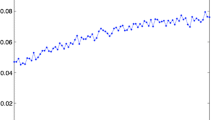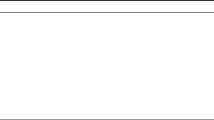Abstract
After a clustering solution is generated automatically, labelling these clusters becomes important to help understanding the results. In this paper, we propose to use a mutual information based method to label clusters of journal articles. Topical terms which have the highest normalised mutual information with a certain cluster are selected to be the labels of the cluster. Discussion of the labelling technique with a domain expert was used as a check that the labels are discriminating not only lexical-wise but also semantically. Based on a common set of topical terms, we also propose to generate lexical fingerprints as a representation of individual clusters. Eventually, we visualise and compare these fingerprints of different clusters from either one clustering solution or different ones.



Similar content being viewed by others
Notes
If a cluster covers 10% of the total dataset, then the term is expected to occur 10% of its occurrences over the total dataset.
The topical terms were extracted from the titles and abstracts of the articles in the Astro dataset. Please refer to Koopman et al. (2017) for more details.
Please see Table 1 in Koopman et al. (2017).
We applied the Python package provided at http://scikit-learn.org/stable/modules/generated/sklearn.cluster.AffinityPropagation.html with all default parameter settings. Further investigation with this clustering exercise is out of the scope of this paper.
References
Applegate, D. L., Bixby, R. E., Chvatal, V., & Cook, W. J. (2007). The traveling salesman problem: A computational study (Princeton series in applied mathematics). Princeton: Princeton University Press.
Koopman, R., Wang, S., & Scharnhorst, A. (2017). Contextualization of topics—Browsing through the universe of bibliographic information. In J. Gläser, A. Scharnhorst, & W. Glänzel (Eds.), Same data—Different results?. Special issue of scientometrics: Towards a comparative approach to the identification of thematic structures in science. doi:10.1007/s11192-017-2303-4.
Manning, C. D., Raghavan, P., & Schütze, H. (2008). Introduction to Information Retrieval. Cambridge: Cambridge University Press.
Martin, O., Otto, S. W., & Felten, E. W. (1991). Large-step markov chains for the traveling salesman problem. Complex Systems, 5, 299–326.
Velden, T., Boyack, K., van Eck, N., Glänzel, W., Gläser, J., & Havemann, F., et al. (2017). Comparison of topic extraction approaches and their results. In J. Gläser, A. Scharnhorst, & W. Glänzel (Eds.), Same data—Different results?. Special issue of scientometrics: Towards a comparative approach to the identification of thematic structures in science. doi:10.1007/s11192-017-2306-1.
Wang, S., & Koopman, R. (2017). Clustering articles based on semantic similarity. In J. Gläser, A. Scharnhorst, & W. Glänzel (Eds.), Same data–Different results?. Special issue of Scientometrics: Towards a comparative approach to the identification of thematic structures in science. doi:10.1007/s11192-017-2298-x.
Acknowledgements
Part of this work has been funded by the COST Action TD1210 Knowescape. We would like to thank Marcus John, who functioned as domain expert, for his valuable analysis of the cluster labels. We would like to thank Michael Heinz for discussions on the method.
Author information
Authors and Affiliations
Corresponding author
Rights and permissions
About this article
Cite this article
Koopman, R., Wang, S. Mutual information based labelling and comparing clusters. Scientometrics 111, 1157–1167 (2017). https://doi.org/10.1007/s11192-017-2305-2
Received:
Published:
Issue Date:
DOI: https://doi.org/10.1007/s11192-017-2305-2




